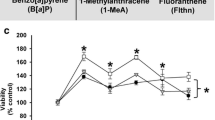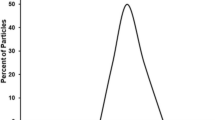Abstract
This study presents a new strategy for the carcinogenic evaluation of complex chemical mixtures based on genotoxic and nongenotoxic assays. We studied the ability of organic extracts of diesel exhaust particles (DEP) to induce point mutations in five different Salmonella typhimurium strains (Ames test) and to inhibit gap junction intercellular communication (GJIC) in rat liver epithelial cell lines. A crude extract of DEP was prepared by extraction with dichloromethane (DCM), and fractionated according to polarity into five fractions: aliphatic hydrocarbons, polycyclic aromatic hydrocarbons (PAH), nitro-PAH, dinitro-PAH, and polar compounds. Statistical experimental design, multivariate data analysis, and modeling were used to quantify the mutagenicity of individual and combined DEP fractions in the Ames assay. Quantitative determination of GJIC was carried out using a recently described combination of scrape loading and digital image analysis. Both assays responded to the DEP extract, but the responses were due to different fractions. The nitro-PAH fraction showed the strongest mutagenic potential, followed by the dinitro-PAH fraction. The effect on GJIC was due to the fraction containing the polar components, followed by the dinitro-PAH fraction. The extract was found to induce both basepair substitutions and frameshift mutations, through activation by bacterial nitroreductases. Hyperphosphorylation of connexin43, the major connexin in the epithelial cell lines, was less evident for DEP extract than for other communication inhibitors such as phorbol esters and growth factors, and consequently inhibitors of the protein kinase C (PKC) and mitogen-activated protein (MAP) kinase pathway were unable to counteract the inhibition by DEP extract. Since the Ames test is a well accepted method to screen for substances with genotoxic activity while inhibition of GJIC is associated with effect of tumor promoters and nongenotoxic carcinogens, it is not surprising but encouraging and interesting that the present data indicate that the two endpoints supplement each other as screening tests and in the evaluation of hazardous compounds in complex mixtures.







Similar content being viewed by others
References
Alsberg T, Stenberg R, Westerholm M, Strandell M, Rannug U, Sundvall A, Romert V, Bernson B, Pettersson R, Toftgård R, Franzen B, Jansson M, Gustafsson JÅ, Egeback KE, Telje G (1985) Chemical and biological characterization of organic material from gasoline exhaust particles. Environ Sci Technol 19:43–50
Ames BN, Durston WE, Yamasaki E, Lee FD (1973) Carcinogens are mutagens: a simple test system combining liver homogenates for activation and bacteria for detection. Proc Natl Acad Sci U S A 70:2281–2285
Baxter CS, Miller ML (1987) Mechanism of mouse skin tumor promotion by n-dodecane. Carcinogenesis 8:1787–1790
Boffetta P, Dosemeci M, Gridley G, Bath H, Moradi T, Silverman D (2001) Occupational exposure to diesel engine emissions and risk of cancer in Swedish men and women. Cancer Causes Control 12:365–374
Box GEP, Hunter WG, Hunter JS (1978) Statistics for experimenters: an introduction to design, data analysis, and model building. Wiley, New York
Castagna M, Takai Y, Kaibuchi K, Sano K, Kikkawa U, Nishizuka Y (1982) Direct activation of calcium-activated, phospholipid-dependent protein kinase by tumor-promoting phorbol esters. J Biol Chem 257:7847–7851
Claxton LD, Creason J, Leroux B, Agurell E, Bagley S, Bryant DW, Courtois YA, Douglas G, Clare CB, Goto S, (1992) Results of the IPCS collaborative study on complex mixtures. Mutat Res 276:23–32
Crebelli R, Fuselli S, Conti G, Conti L, Carere A (1991) Mutagenicity spectra in bacterial strains of airborne and engine exhaust particulate extracts. Mutat Res 261:237–248
Dudley DT, Pang L, Decker SJ, Bridges AJ, Saltiel AR (1995) A synthetic inhibitor of the mitogen-activated protein kinase cascade. Proc Natl Acad Sci U S A 92:7686–7689
Eide I, Zahlsen K (1996) Inhalation experiments with mixtures of hydrocarbons. Experimental design, statistics and interpretation of kinetics and possible interactions. Arch Toxicol 70:397–404
Gekeler V, Boer R, Uberall F, Ise W, Schubert C, Utz I, Hofmann J, Sanders KH, Schachtele C, Klemm K, Grunicke H (1996) Effects of the selective bisindolylmaleimide protein kinase C inhibitor GF 109203X on P-glycoprotein-mediated multidrug resistance. Br J Cancer 74:897–905
Hirayama T, Watanabe T, Akita M, Shimomura S, Fujioka Y, Ozasa S, Fukui S (1988) Relationships between structure of nitrated arenes and their mutagenicity in Salmonella typhimurium; 2- and 2,7-nitro substituted fluorene, phenanthrene and pyrene. Mutat Res 209:67–74
Hossain MZ, Ao P, Boynton AL (1998) Rapid disruption of gap junctional communication and phosphorylation of connexin43 by platelet-derived growth factor in T51B rat liver epithelial cells expressing platelet-derived growth factor receptor. J Cell Physiol 174:66–77
International Agency for Research on Cancer (IARC) (1997) Cancer incidence in five continents. Scientific publ no 6. IARC, Lyon
Kenne K, Fransson-Steen R, Honkasalo S, Warngard L (1994) Two inhibitors of gap junctional intercellular communication, TPA and endosulfan: different effects on phosphorylation of connexin 43 in the rat liver epithelial cell line, IAR 20. Carcinogenesis 15:1161–1165
Kettaneh-Wold N (1992) Analysis of mixture data with partial least squares. Chemomet Intell Lab Syst 14:57–69
Ku WC, Cheng AJ, Wang TC (1997) Inhibition of telomerase activity by PKC inhibitors in human nasopharyngeal cancer cells in culture. Biochem Biophys Res Commun 241:730–736
Kvalheim OM (1989) Model-building in chemistry, a unified approach. Anal Chim Acta 223:53–73
Lankas GR, Baxter CS, Christian RT (1978) Effect of alkane tumor-promoting agents on chemically induced mutagenesis in cultured V79 Chinese hamster cells. J Toxicol Environ Health 4:37–41
Lee H, Cherng SH, Liu TY (1994) Bacterial mutagenicity, metabolism, and DNA adduct formation by binary mixtures of benzo [a]pyrene and 1-nitropyrene. Environ Mol Mutagen 24:229–234
Lipsett M, Campleman S (1999) Occupational exposure to diesel exhaust and lung cancer: a meta- analysis. Am J Public Health 89:1009–1017
Lo CW (1999) Genes, gene knockouts, and mutations in the analysis of gap junctions. Dev Genet 24:1–4
Loewenstein WR (1980) Junctional cell-to-cell communication and growth control. Ann N Y Acad Sci 339:39–45
Manabe Y, Kinouchi T, Ohnishi Y (1985) Identification and quantification of highly mutagenic nitroacetoxypyrenes and nitrohydroxypyrenes in diesel-exhaust particles. Mutat Res 158:3–18
Maron DM, Ames BN (1983) Revised methods for the Salmonella mutagenicity test. Mutat Res 113:173–215
McCoy EC, Rosenkranz HS, Mermelstein R (1981) Evidence for the existence of a family of bacterial nitroreductases capable of activating nitrated polycyclics to mutagens. Environ Mutagen 3:421–427
McCoy EC, Anders M, Rosenkranz HS (1983) The basis of the insensitivity of Salmonella typhimurium strain TA98/1:8-DNP6 to the mutagenic action of nitroarenes. Mutat Res 121:17–23
Minamoto T, Mai M, Ronai Z (1999) Environmental factors as regulators and effectors of multistep carcinogenesis. Carcinogenesis 20:519–527
Musil LS, Goodenough DA (1991) Biochemical analysis of connexin43 intracellular transport, phosphorylation, and assembly into gap junctional plaques. J Cell Biol 115:1357–1374
Musil LS, Beyer EC, Goodenough DA (1990) Expression of the gap junction protein connexin43 in embryonic chick lens: molecular cloning, ultrastructural localization, and post-translational phosphorylation. J Membr Biol 116:163–175
Nakagawa R, Kitamori S, Horikawa K, Nakashima K, Tokiwa H (1983) Identification of dinitropyrenes in diesel-exhaust particles. Their probable presence as the major mutagens. Mutat Res 124:201–211
Oh SY, Grupen CG, Murray AW (1991) Phorbol ester induces phosphorylation and down-regulation of connexin 43 in WB cells. Biochim Biophys Acta 1094:243–245
Opsahl H, Rivedal E (2000) Quantitative determination of gap junction intercellular communication by scrape loading and image analysis. Cell Adhes Commun 7:367–375
Østby L, Engen S, Melbye A, Eide I (1997) Mutagenicity testing of organic extracts of diesel exhaust particles after fractionation and recombination. Arch Toxicol 71:314–319
Pang L, Sawada T, Decker SJ, Saltiel AR (1995) Inhibition of MAP kinase kinase blocks the differentiation of PC-12 cells induced by nerve growth factor. J Biol Chem 270:13585–13588
Pitts JN Jr, Lokensgard DM, Harger W, Fisher TS, Mejia V, Schuler JJ, Scorziell GM, Katzenstein YA (1982) Mutagens in diesel exhaust particulate. Identification and direct activities of 6-nitrobenzo[a]pyrene, 9-nitroanthracene, 1-nitropyrene and 5h-phenanthro[4:5-bcd]pyran-5-one. Mutat Res 103:241–249
Rivedal E, Opsahl H (2001) Role of PKC and MAP kinase in EGF- and TPA-induced connexin43 phosphorylation and inhibition of gap junction intercellular communication in rat liver epithelial cells. Carcinogenesis 22:1543–1550
Rivedal E, Yamasaki H, Sanner T (1994) Inhibition of gap junctional intercellular communication in Syrian hamster embryo cells by TPA, retinoic acid and DDT. Carcinogenesis 15:689–694
Rivedal E, Mikalsen S, Sanner T (2000) Morphological transformation and effect on gap junction intercellular communication in Syrian hamster embryo cells as screening tests for carcinogens devoid of mutagenic activity. Toxicol Vitr 14:185–192
Rosenkranz HS, Pollack N, Cunningham AR (2000) Exploring the relationship between the inhibition of gap junctional intercellular communication and other biological phenomena. Carcinogenesis 21:1007–1011
Saez JC, Martinez AD, Branes MC, Gonzalez HE (1998) Regulation of gap junctions by protein phosphorylation. Braz J Med Biol Res 31:593–600
Sanner T, Dybing E, Willems MI, Kroese ED (2001) A simple method for quantitative risk assessment of non-threshold carcinogens based on the dose descriptor T25. Pharmacol Toxicol 88:331–341
Swierenga SH, Yamasaki H (1992) Performance of tests for cell transformation and gap-junction intercellular communication for detecting nongenotoxic carcinogenic activity. IARC Sci Publ 165–193
Tennant RW, Ashby J (1991) Classification according to chemical structure, mutagenicity to Salmonella and level of carcinogenicity of a further 39 chemicals tested for carcinogenicity by the U.S. National Toxicology Program. Mutat Res 257:209–227
Upham BL, Weis LM, Trosko JE (1998) Modulated gap junctional intercellular communication as a biomarker of PAH epigenetic toxicity: structure-function relationship. Environ Health Perspect 106 Suppl 4:975–981
Wang YY, Talcott RE, Seid DA, Wei ET (1981) Antimutagenic properties of liver homogenates, proteins and glutathione on diesel exhaust particulates. Cancer Lett 11:265–275
Warn-Cramer BJ, Lampe PD, Kurata WE, Kanemitsu MY, Loo LW, Eckhart W, Lau AF (1996) Characterization of the mitogen-activated protein kinase phosphorylation sites on the connexin-43 gap junction protein. J Biol Chem 271:3779–3786
Warn-Cramer BJ, Cottrell GT, Burt JM, Lau AF (1998) Regulation of connexin-43 gap junctional intercellular communication by mitogen-activated protein kinase. J Biol Chem 273:9188–9196
Warngard L, Bager Y, Kato Y, Kenne K, Ahlborg UG (1996) Mechanistical studies of the inhibition of intercellular communication by organochlorine compounds. Arch Toxicol Suppl 18:149–159
Westerholm R, Almen J, Li H, Rannug JU, Egeback KE (1991) Chemical and biological characterization of particulate,- semivolatile,- and gas-phase-associated compounds in diluted heavy-duty diesel exhausts: a comparison of three different semivolatile-phase samplers. Environ Sci Technol 25:332–338
Yamasaki H, Ashby J, Bignami M, Jongen W, Linnainmaa K, Newbold RF, Nguyen-Ba G, Parodi S, Rivedal E, Schiffmann D, Simons JW, Vasseur P (1996) Nongenotoxic carcinogens: development of detection methods based on mechanisms: a European project. Mutat Res 353:47–63
Acknowledgements
The authors are grateful to Solveig Engen, Statoil Research Centre, for valuable support and discussions, and to Astri Nordahl and Randi Skibakk, Institute for Cancer Research, for excellent technical assistance.
Author information
Authors and Affiliations
Corresponding author
Rights and permissions
About this article
Cite this article
Rivedal, E., Myhre, O., Sanner, T. et al. Supplemental role of the Ames mutation assay and gap junction intercellular communication in studies of possible carcinogenic compounds from diesel exhaust particles. Arch Toxicol 77, 533–542 (2003). https://doi.org/10.1007/s00204-003-0483-6
Received:
Accepted:
Published:
Issue Date:
DOI: https://doi.org/10.1007/s00204-003-0483-6




